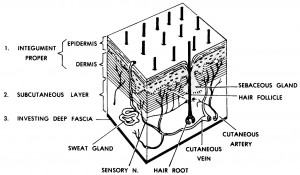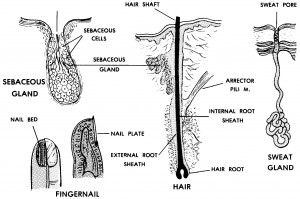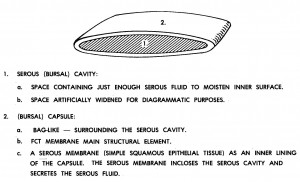Basic Human Anatomy
Lesson 3: The Human Integumentary and Fascial Systems
Welcome to Lesson 3 of the Basic Human Anatomy Course. Today, we’ll be studying the Human Integumentary and Fascial Systems.
I have 5 goals for you in this lesson:
1. Be able to Define the terms
a. integumentary system
b. integument proper
c. integumentary derivatives
d. fascia
e. superficial fascia (subcutaneous layer)
f. deep fasciae, and
g. investing deep fascia.
2. Identify the three coverings, or envelopes, of the human body.
3. Name and describe the two layers of the skin.
4. Name and describe three types of integumentary derivatives, such as hairs, glands, and nails.
5. Define serous cavities, describe a bursa, and give examples of serous cavities in the body.
DEFINITIONS
An organ system is a group of organs together performing an overall function. Portions of two organ systems, the integumentary and fascial systems, are represented in figure 3-1.

Figure 3-1. The integument and related structures.
Integumentary System
The integumentary system includes the integument proper and the integumentary derivatives. We know the integument proper as the skin.
It is the outermost covering of the whole body. The integumentary derivatives include the hairs, nails, and various glands of the skin.
Fascial System
A fascia is a sheet or collection of fibrous connective tissue (FCT). The superficial fascia is the connective tissue which lies immediately beneath the skin and is often known as the subcutaneous layer. Deep fasciae (plural) form envelopes for muscles and other organs and fill spaces. One deep fascial membrane is the third envelope of the whole body, beneath the skin and the subcutaneous layer. It is known as the investing deep fascia.
COVERINGS OF THE HUMAN BODY
The entire body is surrounded by three layers or envelopes, one inside the other. These coverings separate the body from the external environment. These envelopes include (from outside inward)–the skin (the integument proper), the subcutaneous layer, and the investing deep fascia.
THE HUMAN INTEGUMENTARY SYSTEM
THE INTEGUMENT PROPER
The integument proper is the outermost layer of the human body. It is usually known as the skin. The skin has two layers–the superficial or outer layer called the epidermis and the deeper or inner layer called the dermis.
The Epidermis
The epidermis is a stratified squamous epithelium. This means that it is made up of several layers of cells, the outermost being flat-type epithelial cells.
The outer layers of the epidermis include cells which are transparent, flattened, dead, and without nuclei. These hardened cells of the outermost layers are completely filled with keratin and are known as cornified cells. These dead flat cells in the outermost layers resemble scales. Day by day, these cells are scraped away or just fall away from the body. They are replaced by cells from the intermediate layers.
In the intermediate layers of the epidermis, the cells change their shapes. As the cells move towards the surface, they gain granules, begin to manufacture a hardening material called keratin, and lose their nuclei.
The innermost layer of the epidermis is especially important because it is the source of all the other layers of the epidermis. It is known as the basal or germinative layer. The cells of this layer are capable of multiplication (mitosis). Its basic structure is a single layer of columnar-type epithelial cells.
The Dermis (Dermal Layer)
The dermis is the layer of the skin lying just beneath the epidermis. It is dense FCT consisting of white and yellow fibers. This layer in animal hides is used to make leather. The dermis has finger-like projections called papillae. These papillae extend into the epidermis and keep the dermis and epidermis from sliding on each other. The dermal layer includes blood vessels, lymph vessels, nerve endings, hair follicles, and glands.
INTRODUCTION TO INTEGUMENTARY DERIVATIVES
The integumentary derivatives include the glands, hairs, and nails associated with the skin. All integumentary derivatives are formed from the tissues of the integument proper (dermis and epidermis). All are appended (attached) to the integument proper and are often known as the appendages of the skin. See figure 3-2.

Figure 3-2. The integumentary derivatives (appendages).
HAIRS
A hair follicle is formed by the extension of the skin (dermis and epidermis) deeper into the surface of the body. Follicles may extend into the subcutaneous layer.
At the base of the hair follicle is the hair root. The hair shaft grows out from the root. The hair shaft is made of cells from the outermost layers of the epidermis.
Scalp and facial hairs grow continuously. Other hairs of the body grow to fixed lengths. The types and patterns of hairs are determined for each individual by genetics, including his/her sex.
GLANDS
The types of glands included are the sweat glands, the sebaceous (fat/ oil) glands, and the mammary glands (breasts). The ducts and secretory parts of these glands are made of epithelial tissues. Backup or supporting tissue is of FCT.
Sweat Glands
Sweat glands consist of a coiled secretory portion and a wavy duct which leads to the surface of the skin. The coiled secretory portion is located in the dermis or deeper. Sweat glands are found everywhere on the body in association with the skin.
Sebaceous Glands
Sebaceous glands produce an oily substance which lubricates the skin and hairs. The oil keeps the skin and hairs flexible. The sebaceous glands are usually found as a part of the walls of hair follicles and their oil flows into the follicle. In a few places without hairs, they open directly to the skin surface.
Mammary Glands
In the adult human female, the mammary gland lies in the subcutaneous layer anterior to the chest muscle (pectoralis major M.). Its function is to nourish the newborn. A nipple is located near the center of each breast. Around each nipple is a darkened area known as the areola. The tip of the nipple has many small openings to allow the passage of the milk from the milk ducts. These ducts are connected to lobes of glandular tissue located throughout the breast. Fat and fibrous CT fill in the spaces among the lobes.
NAILS
Nails are found on the ends of the digits (thumbs, fingers, and toes). Nails help to protect the ends of these digits. Each nail bed is attached to the top of the terminal phalanx (bone) of each digit. The nail itself is made up of cornified (hardened) outer cell layers of the epidermis. The nails grow continuously from their roots.
SKIN COLORATION
The skin includes red, black, and yellow pigments. The proportion of these pigments determines the skin color. This proportion is determined by genetics. The absence of all pigments is called albinism. In albinism, white light is reflected and a pink hue results from the color of the blood shining through the transparent skin. These pigments are the source of hair color as well as the skin color.
THE FASCIAL SYSTEM OF THE HUMAN BODY
GENERAL
Most of the fibrous connective tissues (FCT) are fascial. These may occur as sheets or masses. NOT included in this definition are the tendons, ligaments, or aponeuroses (wide flat tendons). The different fasciae have varying proportions of white fibers, yellow fibers, fat, and tissue fluid. Some serve as membranes to enclose the body and its parts. Fasciae also help to support some organs and allow motions between other organs to be easier.
SUPERFICIAL FASCIA
The superficial fascia is the second envelope of the body. It is the layer between the skin (integument proper) and the investing deep fascial envelope. It is often called the subcutaneous layer, but it is technically not a part of the integumentary system as such.
The superficial fascia is made up primarily of loose areolar FCT with the spaces filled by fatty tissue and tissue fluid. It contains the superficial or cutaneous branches of nerves, arteries, veins, and lymphatics of the skin. These four components can be remembered through the use of the acronym NAVL, for Nerves, Arteries, Veins, and Lymphatics.
DEEP FASCIAE
The deep fasciae include various membranes made of consolidated or dense FCT. A deep fascia envelops the entire body as the third envelope. This third envelope is known as the investing deep fascia. It is beneath the skin and subcutaneous layer.
Deep fasciae also include the envelopes of the muscles and other organs. Around individual organs (for example, the kidney), it is called a capsule.
Another form of deep fascia is found in the collections of loose areolar FCT and fat that are found as filling among the organs. Similar deep fasciae attach organs to the body wall.
SEROUS CAVITIES OF THE HUMAN BODY
GENERAL
The term serous refers to a watery- type fluid. Serous cavities are sacs lined with serous membranes. These cavities serve as lubricating devices. They reduce the friction during the motion between organs.
BURSA
A bursa (figure 3-3) is the simplest of serous cavities. Each bursa is a small sac located between two moving structures, usually a muscle moving over a bony surface. The bursa reduces the friction between the two structures. For example, a bursa prevents excessive friction between the skin and patella (knee cap). This bursa, called the prepatellar bursa, allows the skin to move freely over the patella. (When injured, it produces excessive amounts of the serous fluid and is known as “housemaid’s knee.”)

Figure 3-3. A bursa–the simplest serous cavity.
As a fibrous sac, each bursa has a central cavity which is lined with a serous membrane. This membrane is a simple squamous epithelium. The serous membrane secretes a serous fluid into the serous cavity. The serous fluid is the lubricant, minimizing friction.
OTHER SEROUS CAVITIES OF THE BODY
Other important serous cavities are associated with the major hollow organs, referred to as visceral organs. Each lung is encased in a serous cavity called the pleural cavity. The heart lies in a serous cavity called the pericardial cavity. The intestines are allowed to move freely during the digestive processes within the peritoneal cavity.
Each serous cavity has an inner and an outer membrane. The inner membrane is intimately associated with the surface of the visceral organ. The outer membrane forms the outer wall of the cavity. The serous lining of the cavity secretes the serous fluid into the cavity o act as a lubricant between the membranes, allowing freer motion for the organs.
Introduction to Basic Human Anatomy is a distance learning product that is based on the Correspondence Subcourse MD0006 of the U.S. Army Medical Department Center and School. This presentation was produced by the Brookside Associates, Ltd., which is privately-held and not connected to any governmental agency. The views expressed here are those of the authors, and unless otherwise noted, do not necessarily reflect the views of the Brookside Associates, Ltd., any governmental agencies or private organizations. This presentation is unclassified, and © 2009, with all rights reserved.
